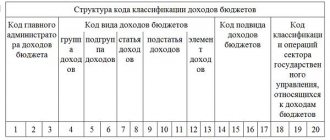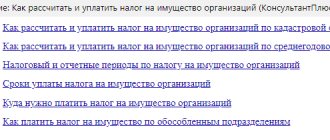To pay taxes and contributions on payment receipts, a special budget classification code is used. This article provides information about the tax according to KBK 18210606043101000110, decoding 2018-2019 for this number.
The budget classification code is intended to identify the payment: to which department the funds were sent, for what purposes. The receipt has a separate field for this - cell 08. When paying property fees, write KBK 18210606043101000110 in this field. Which tax is specifically indicated by this number is described below.
KBK for payment of land tax
| TAX | KBK |
| Land tax levied within the boundaries of intra-city municipalities of federal cities (Moscow, St. Petersburg, Sevastopol) | 182 1 06 06031 03 1000 110 |
| Land tax levied within the boundaries of urban districts | 182 1 06 06032 04 1000 110 |
| Land tax levied within the boundaries of urban districts with intra-city division | 182 1 06 06032 11 1000 110 |
| Land tax levied within the boundaries of intra-city areas | 182 1 06 06032 12 1000 110 |
| Land tax levied within the boundaries of urban settlements | 182 1 06 06033 13 1000 110 |
| Land tax levied within the boundaries of intersettlement territories | 182 1 06 06033 05 1000 110 |
| Land tax levied within the boundaries of rural settlements | 182 1 06 06033 10 1000 110 |
KBC for 2021: current list of budget classification codes (table)
Cheat sheet for using budget classification codes
Budget classification codes (BCC) were introduced in order to streamline the flow of money into the budget and its expenditure. Using these codes, budget funds are grouped, including taxes and insurance contributions.
For example, all personal income tax receipts are divided into groups: personal income tax accrued by tax agents; Personal income tax accrued by entrepreneurs and other “private owners”; Personal income tax in the form of fixed advance payments on the income of non-residents, etc.
And for each of these groups there is a separate budget classification code.
First of all, the BCC must be indicated in payment orders when transferring taxes, fees, penalties and fines. In the current form of payment, given in Appendix 3 to the Regulations of the Bank of Russia dated June 19.
12 No. 383-P, field 104 is intended for KBK (for more information about filling out a payment order, read the article “Instructions for filling out payment orders when paying taxes, penalties, fines, as well as contributions to extra-budgetary funds”). Please note that only one budget classification code can be specified in a payment order.
If you have to make payments related to two, three or more BCCs, you will have to issue two, three or more payments.
In addition, the BCC should be indicated in some tax returns: for income tax, for VAT, for transport tax, and also in the calculation of insurance premiums. This allows inspectors to record arrears of payment with one or another cash register company on the taxpayer’s personal account. As soon as the amount indicated by this BCC is received from this taxpayer, the debt will be repaid.
Read more
According to the Procedure for the formation and application of budget classification codes of the Russian Federation (approved by order of the Ministry of Finance dated 06.06.19 No. 85n), each BCC consists of 20 digits (they are called digits).
The first three digits are the code of the chief budget revenue administrator. For tax payments, insurance contributions (except for contributions “for injuries”) and state duties, this code takes the value “182”, for payments to the Social Insurance Fund “for injuries” - “393”.
The fourth, fifth and sixth digits show the income group. For income tax and personal income tax - this is “101”, for insurance premiums - “102”, for VAT and excise taxes - “103”, for property tax, transport and land taxes - “106”, for unified taxes with “simplified” , UTII and Unified Agricultural Tax - “105”, for state duty - “108”.
Digits seven through eleven are used to provide detail within each income group.
The twelfth and thirteenth categories show which budget the money will go to. If “01” is indicated, then the funds are intended for the federal budget, if “02”, then for the regional one. The values “06”, “07” and “08” mean the budgets of the Pension Fund, Social Insurance Fund and Compulsory Medical Insurance Fund, respectively. Values “03”, “04” and “05” are reserved for municipal budgets
The fourteenth to seventeenth digits show what exactly the taxpayer or policyholder is transferring: the main payment of the tax or contribution, penalties, fines or interest. For taxes and some types of contributions, in the case of the main payment indicate “1000”, in the case of penalties – “2100”, in the case of fines – “3000” and in the case of interest – “2200”.
The eighteenth, nineteenth and twentieth categories take the following values: when paying taxes and state duties it is “110”, when paying insurance premiums - “160”, when transferring payments for the use of subsoil or natural resources - “120”.
Kbk for taxes and contributions for past periods
The Ministry of Finance periodically makes changes to the list of existing BCCs. In particular, in 2021, the codes relating to insurance premiums, penalties and interest were updated (see “How the BCC for payment of insurance premiums will change from 2016”).
An accountant should remember one important rule: as soon as new BCC values appear, the previous values become ineffective and cannot be used.
When transferring a tax or contribution for the previous period, in the payment you must indicate the budget classification code, which is relevant now, and not in the previous period.
That is why, to fill out payment forms, it is better to use a web service, where all necessary updates are installed automatically, without user intervention, and the likelihood of making a mistake is negligible.
By the way, for some taxes there is a separate operating BCC for payments for past periods. An example is the single tax on imputed income. There is a current code that must be specified if in 2019 the “imputed” person transfers UTII for periods that expired before January 1, 2011. Similar codes have been introduced for the simplified tax system and the unified agricultural tax.
If a special BCC for payments for past periods is not provided, then the current code applies to all transfers regardless of the period. This applies, among other things, to income tax, VAT, personal income tax and insurance premiums.
The situation is exactly the same with the codes that must be indicated in updated declarations for previous periods.
If a taxpayer submits a “clarification” in 2021 for 2021 or earlier periods, he must enter the BCC effective in 2019.
Otherwise, it will turn out that the debt on the personal account is listed using an outdated code, but the payment was received using the current code. As a result, the debt will remain outstanding.
When filling out payments or declarations in a web service, an accountant or entrepreneur will not have to keep track of all these details. When specifying the type of tax, payment period and declaration status, the service simply will not allow you to indicate incorrect values.
What to do if the KBK is indicated with an error
In theory, an incorrectly indicated budget classification code on a payment slip (as well as an outdated BCC) does not mean that a tax or contribution has not been paid. This directly follows from Article 45 of the Tax Code of the Russian Federation. But in practice, the inspectorate and the treasury are not able to quickly figure out how to reflect an erroneous payment on a personal account. And until the payment is offset, the taxpayer will remain in arrears.
To rectify the situation, it is better to submit an application to the Federal Tax Service to clarify the payment, attaching a payment application with the bank’s mark.
Having received these documents, tax authorities will most likely conduct a reconciliation with the budget.
Based on its results, the auditors will credit the amount with the incorrect BCC to pay off the arrears (for more information about clarifying the payment, read the article “What to do if there is an error in the tax payment slip”).
If an error is made when filling out the declaration, then it is enough to submit a “clarification” with the correct BCC, and the incident will be resolved.
Elena Mavritskaya, leading expert at Online Accounting.
Source: https://www.Buhonline.ru/kbk-2020
KBK for payment of penalties for land tax
| PENALIES, INTEREST, FINES | KBK | |
| Penalties, interest, penalties for land tax collected within the boundaries of intra-city municipalities of federal cities (Moscow, St. Petersburg, Sevastopol) | penalties | 182 1 06 06031 03 2100 110 |
| interest | 182 1 06 06031 03 2200 110 | |
| fines | 182 1 06 06031 03 3000 110 | |
| Penalties, interest, fines on land tax levied within the boundaries of urban districts | penalties | 182 1 06 06032 04 2100 110 |
| interest | 182 1 06 06032 04 2200 110 | |
| fines | 182 1 06 06032 04 3000 110 | |
| Penalties, interest, fines on land tax levied within the boundaries of urban districts with intra-city division | penalties | 182 1 06 06032 11 2100 110 |
| interest | 182 1 06 06032 11 2200 110 | |
| fines | 182 1 06 06032 11 3000 110 | |
| Penalties, interest, fines on land tax levied within the boundaries of intracity districts | penalties | 182 1 06 06032 12 2100 110 |
| interest | 182 1 06 06032 12 2200 110 | |
| fines | 182 1 06 06032 12 3000 110 | |
| Penalties, interest, fines on land tax levied within the boundaries of urban settlements | penalties | 182 1 06 06033 13 2100 110 |
| interest | 182 1 06 06033 13 2200 110 | |
| fines | 182 1 06 06033 13 3000 110 | |
| Penalties, interest, fines on land tax levied within the boundaries of inter-settlement territories | penalties | 182 1 06 06033 05 2100 110 |
| interest | 182 1 06 06033 05 2200 110 | |
| fines | 182 1 06 06033 05 3000 110 | |
| Penalties, interest, fines on land tax levied within the boundaries of rural settlements | penalties | 182 1 06 06033 10 2100 110 |
| interest | 182 1 06 06033 10 2200 110 | |
| fines | 182 1 06 06033 10 3000 110 | |
FILES
Decoding KBK 18210606043101000110
Movable and immovable property of Russian citizens is subject to a tax on property, transport and land. Depending on the category of duty, the location of the property and the payer, one or another code for the budget classification of income is used.
So, number 18210606043101000110 is used as BCC for paying land tax. Moreover, this fee is paid by citizens who own plots of land located in rural settlements. Accordingly, the budget to which the funds are allocated is the treasury of the local Federal Tax Service.
The group of subtypes of such revenues indicates what kind of payment it is: standard, penalties, interest or fines. In the code under consideration, revenues are standard, calculated according to the tariffs approved by Art. 394 Tax Code of the Russian Federation.
The cipher itself consists of 20 digits grouped in seven blocks. Each group has an individual value that helps identify the payment. Detailed decryption of the code:
- 182 - institution to which the payment was sent: Federal Tax Inspectorate.
- 1 - category of receipts (income or expenses): tax payments.
- 06 - specific type of duty: land tax.
- 06043 - specifies deductions: land tax from individuals whose land property is located in the territory of the city and districts.
- 10 - budget type: city and district.
- 1000 - purpose of payment: standard collection receipts.
- 110 - generalized category of income: tax and customs deductions.
Important points on land tax
Land tax is local, so the budget of the corresponding regional unit must receive it. It must be paid by land owners:
- on the right of ownership;
- those who received them for lifelong use;
- in lifelong inheritable possession.
REFERENCE! This tax does not apply to tenants and those who use land free of charge on a fixed-term basis.
How is land tax calculated?
To determine the tax base, you need to know the following characteristics of the land plot subject to taxation:
- Cadastral value (information is available on the Rosreestr website).
- The owner's share in the rights to this site.
- Ownership coefficient (if the plot has been owned for less than a year).
All this data is multiplied by the tax rate, which depends on the will of the regional authorities.
Notification to individuals
For individuals, the tax authority will calculate everything and send a notification to the place of residence from April to September. You must pay for the notice received before the beginning of October.
ATTENTION! If you find that the tax notice is in error in some way, you need to fill out the application form that will be sent to you along with the notice and send it to the tax office for clarification and recalculation. When the tax office checks everything, it will send you a new notification.
If this document is delayed, lost, or for some other reason does not reach the addressee, do not think that the land tax can be avoided - the law obliges individuals in such cases to independently contact the tax office, unless, of course, you want to get acquainted with fines and penalties .
Tax calculation
The cadastral value of the plot is used as the tax base. If the land plot was acquired in the current year, then a state cadastral valuation is not required. Otherwise, without it, it will not be possible to find out the exact cadastral value, which means it will not be possible to calculate the tax. In fact, the revaluation and calculation of the cadastral value of land is carried out annually. For this reason, certain changes in the tax base occur every year.
When determining the exact cadastral value of the rate, you can independently calculate the accrued tax. To do this, the cadastral value must be multiplied by the tax rate. The resulting amount will be the tax, which should subsequently be paid according to the correct BCC.









